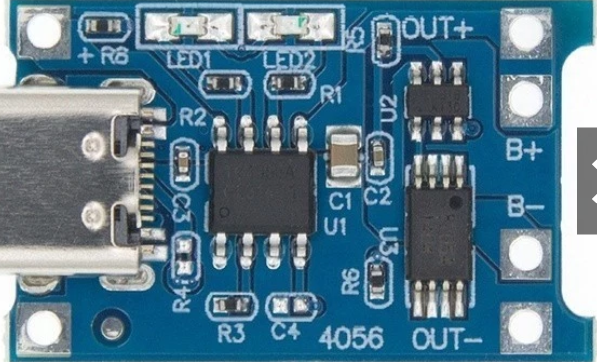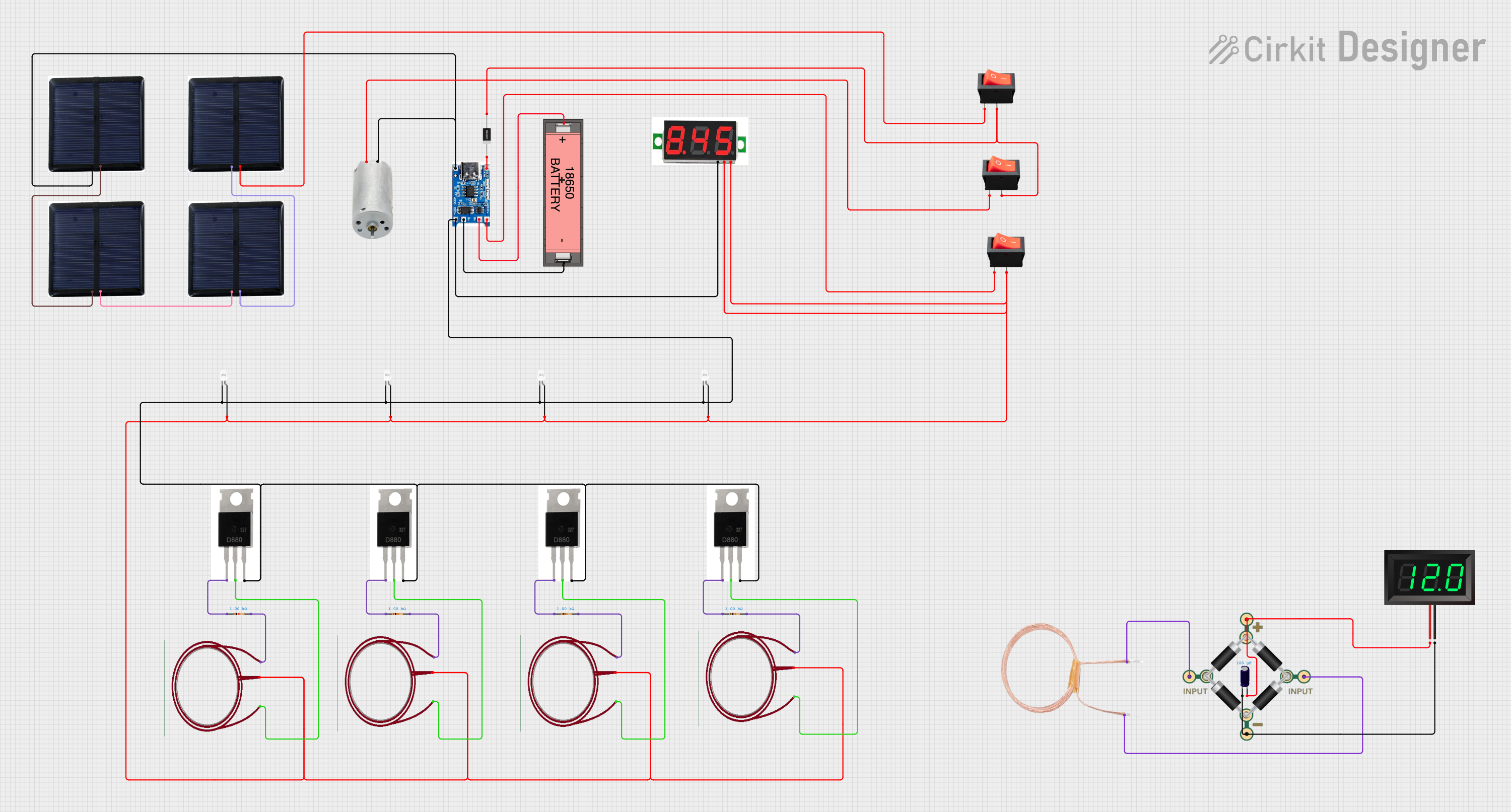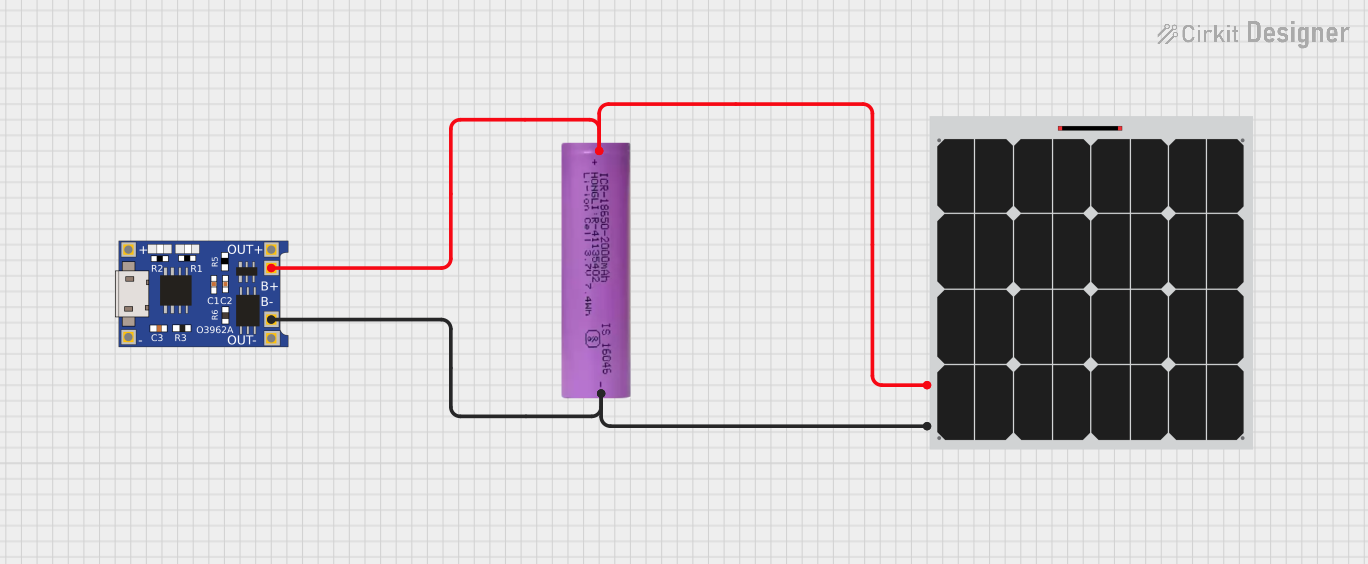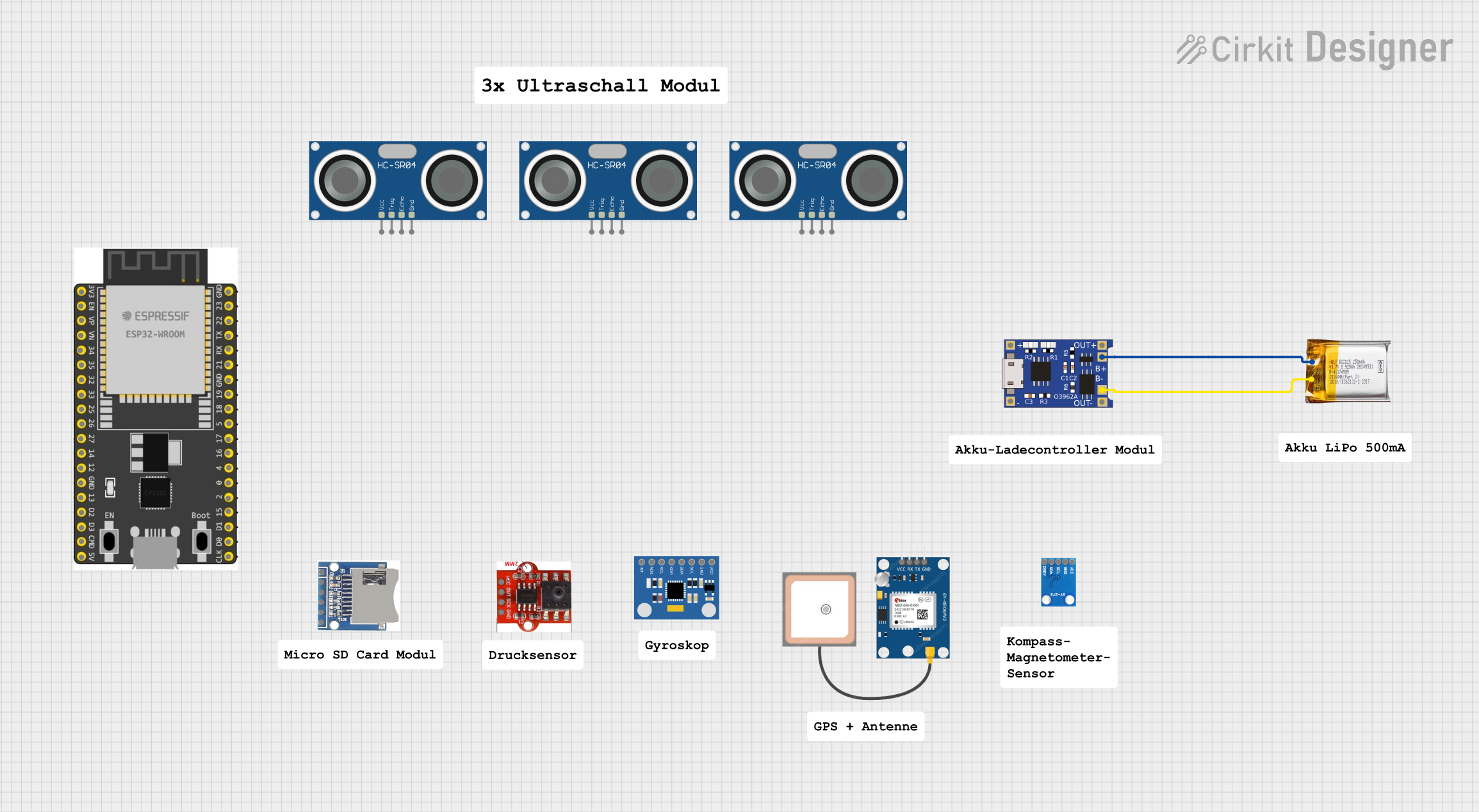
How to Use Charging Module: Examples, Pinouts, and Specs

 Design with Charging Module in Cirkit Designer
Design with Charging Module in Cirkit DesignerIntroduction
A Charging Module is a device designed to manage the charging of batteries, ensuring they are charged safely and efficiently by controlling voltage and current. It is commonly used in battery-powered systems to prevent overcharging, overheating, and damage to the battery. Charging modules are versatile and can be used with various battery types, including lithium-ion, lead-acid, and nickel-metal hydride (NiMH) batteries.
Explore Projects Built with Charging Module

 Open Project in Cirkit Designer
Open Project in Cirkit Designer
 Open Project in Cirkit Designer
Open Project in Cirkit Designer
 Open Project in Cirkit Designer
Open Project in Cirkit Designer
 Open Project in Cirkit Designer
Open Project in Cirkit DesignerExplore Projects Built with Charging Module

 Open Project in Cirkit Designer
Open Project in Cirkit Designer
 Open Project in Cirkit Designer
Open Project in Cirkit Designer
 Open Project in Cirkit Designer
Open Project in Cirkit Designer
 Open Project in Cirkit Designer
Open Project in Cirkit DesignerCommon Applications and Use Cases
- Charging lithium-ion batteries in portable devices (e.g., smartphones, power banks).
- Battery management in renewable energy systems (e.g., solar panels).
- DIY electronics projects requiring rechargeable batteries.
- Robotics and IoT devices powered by rechargeable batteries.
Technical Specifications
Below are the general technical specifications for a typical charging module (e.g., TP4056 module for lithium-ion batteries):
| Parameter | Value |
|---|---|
| Input Voltage | 4.5V to 5.5V |
| Charging Voltage | 4.2V ± 1% |
| Maximum Charging Current | 1A (adjustable in some modules) |
| Battery Type | Lithium-ion (single cell, 3.7V) |
| Protection Features | Overcharge, overcurrent, short circuit |
| Operating Temperature | -10°C to 85°C |
| Dimensions | ~25mm x 19mm x 2mm |
Pin Configuration and Descriptions
| Pin Name | Description |
|---|---|
| IN+ | Positive input terminal for the power supply (e.g., USB 5V or DC adapter). |
| IN- | Negative input terminal for the power supply (ground). |
| BAT+ | Positive terminal for connecting the battery. |
| BAT- | Negative terminal for connecting the battery (ground). |
| OUT+ | Positive output terminal for powering the load (if supported by the module). |
| OUT- | Negative output terminal for powering the load (ground, if supported). |
Usage Instructions
How to Use the Charging Module in a Circuit
Connect the Power Supply:
- Connect a 5V DC power source (e.g., USB cable or adapter) to the
IN+andIN-pins. - Ensure the power supply provides sufficient current for the charging process (e.g., 1A).
- Connect a 5V DC power source (e.g., USB cable or adapter) to the
Connect the Battery:
- Attach the battery's positive terminal to the
BAT+pin and the negative terminal to theBAT-pin. - Ensure the battery is compatible with the module (e.g., single-cell lithium-ion battery).
- Attach the battery's positive terminal to the
Optional Load Connection:
- If the module supports load sharing, connect the load to the
OUT+andOUT-pins. - This allows the module to power the load while charging the battery.
- If the module supports load sharing, connect the load to the
Monitor the Charging Process:
- Most modules include an LED indicator:
- Red LED: Charging in progress.
- Blue/Green LED: Charging complete.
- Most modules include an LED indicator:
Important Considerations and Best Practices
- Battery Compatibility: Ensure the battery type and voltage match the module's specifications.
- Heat Management: Charging modules can generate heat during operation. Use proper ventilation or a heatsink if necessary.
- Avoid Overloading: Do not exceed the module's maximum input current or voltage ratings.
- Polarity Check: Double-check all connections to avoid damaging the module or battery.
Example: Using the Charging Module with an Arduino UNO
You can use the charging module to charge a battery that powers an Arduino UNO. Below is an example of how to monitor the battery voltage using the Arduino:
// Example code to monitor battery voltage using Arduino UNO
const int batteryPin = A0; // Analog pin connected to BAT+ via a voltage divider
const float voltageDividerRatio = 2.0; // Adjust based on your resistor values
const float referenceVoltage = 5.0; // Arduino's reference voltage (5V for UNO)
void setup() {
Serial.begin(9600); // Initialize serial communication
pinMode(batteryPin, INPUT); // Set the battery pin as input
}
void loop() {
int analogValue = analogRead(batteryPin); // Read the analog value
float batteryVoltage = (analogValue / 1023.0) * referenceVoltage * voltageDividerRatio;
// Print the battery voltage to the Serial Monitor
Serial.print("Battery Voltage: ");
Serial.print(batteryVoltage);
Serial.println(" V");
delay(1000); // Wait for 1 second before the next reading
}
Note: Use a voltage divider circuit to ensure the battery voltage does not exceed the Arduino's input voltage range (0-5V).
Troubleshooting and FAQs
Common Issues and Solutions
Module Overheating:
- Cause: Excessive input current or poor ventilation.
- Solution: Reduce the input current or improve airflow around the module.
Battery Not Charging:
- Cause: Incorrect connections or incompatible battery.
- Solution: Verify all connections and ensure the battery matches the module's specifications.
LED Indicators Not Working:
- Cause: Faulty module or insufficient input voltage.
- Solution: Check the input voltage and replace the module if necessary.
Load Not Powering While Charging:
- Cause: Module does not support load sharing.
- Solution: Use a module with load-sharing capability or power the load directly from the battery.
FAQs
Can I use this module to charge multiple batteries in series?
- No, this module is designed for single-cell batteries. Use a specialized charger for multi-cell configurations.
What happens if I leave the battery connected after charging is complete?
- The module includes overcharge protection, so the battery will not be damaged. However, it is good practice to disconnect the battery when not in use.
Can I use a power bank as the input source?
- Yes, as long as the power bank provides a stable 5V output and sufficient current.
By following this documentation, you can safely and effectively use a charging module in your projects.